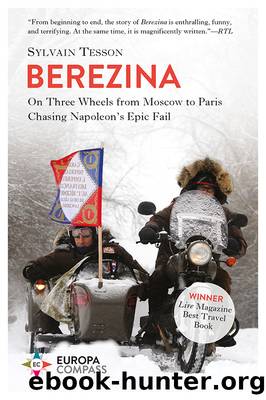Berezina by Sylvain Tesson

Author:Sylvain Tesson
Language: eng
Format: epub
Publisher: Europa Editions
Published: 2019-09-09T16:00:00+00:00
7 Pirsig (Robert M.), Zen and the Art of Motorcycle Maintenance: An Inquiry into Values (William and Morrow, 1974).
DAY FIVE.
FROM BARYSAW TO VILNIUS
At 9 A.M. we were at the Barysaw Museum. Like in all the former Soviet Empire establishments, a dozen fat ladies in woolies were guarding empty rooms. The Napoleonic epic had at least created jobs. The museum was crammed with flags, uniforms, weapons, and wall maps streaked with red arrows. Every year, while ploughing, peasants would dig up cannon shafts, buttons, and rusty helmets. The museum had ended up declining the discoveries.
Goisque, who was a born archeologist, couldn’t pull himself away from the display of cannon balls. “Tesson, do you remember F.’s story?”
During our dinner in Moscow, our friend from Rostov-on-the-Don had told us about his adventure. He’d gotten used to going around the battlefields of the former USSR with a metal detector. One day, in the Berezina mudflats, his device started ringing. He parted the gorses, dug in the silt, and uncovered a ball. He had it identified and received confirmation of something he already knew: it was a piece of Napoleonic artillery. He drove back to the Saint Petersburg airport with his seven-pound treasure and showed up at boarding, with his ball in his hand baggage. No doubt his error was due to his naivety. No sooner had he gone through the security barrier than the arches began to ring, the authorities panicked, bags were searched, and the ball was discovered. Not bothering to explain how a plane could be destroyed with a 1812 cannon ball, the cops forbade him from boarding. Attached to his discovery, F. asked for ten minutes’ grace, left the airport terminal, saw a tree in the parking lot, glanced right and left, and dug a hole in the summer soil, and buried his treasure. Then, after writing down the exact location, he jumped on his plane, hoping to recover his possession some day. Several months later, our friend von Polier was taking some Russian businessmen very important to the survival of his business to Saint Petersburg airport. He had in his suit jacket pocket F.’s instructions and a map scribbled on a page from a school exercise book: “Two steps to the right after the parking meter, third birch from the barrier.” Von Polier asked the financiers to excuse him, “Just give me five minutes, gentlemen.” He ran out into the parking lot, found the cannon ball tree, and started digging. It was winter and the soil was frozen. And here’s this guy in a suit, crouching in a parking lot, busy digging the shoulder with his Montblanc pen. The cannonball brought back to Moscow by rail had place of honor on his piano, between a Golden Ring icon and a portrait of Lenin.
We had to wait for Nina, the museum historian, to arrive. A dog bit Vassily on the calf in the little garden where two-and-a-half inch Pak 40 cannons taken from the Germans in 1940 are on display. The blood drew a flower on the snow.
Download
This site does not store any files on its server. We only index and link to content provided by other sites. Please contact the content providers to delete copyright contents if any and email us, we'll remove relevant links or contents immediately.
| Africa | Americas |
| Arctic & Antarctica | Asia |
| Australia & Oceania | Europe |
| Middle East | Russia |
| United States | World |
| Ancient Civilizations | Military |
| Historical Study & Educational Resources |
Mediterranean Winter by Robert D. Kaplan(842)
Rivers of Power by Laurence C. Smith(835)
Berezina by Sylvain Tesson(723)
Earth: An Intimate History by Richard Fortey(715)
The Revenge of Geography: What the Map Tells Us About Coming Conflicts and the Battle Against Fate by Robert D. Kaplan(543)
Restigouche by Philip Lee(531)
Exceptional Mountains by O. Alan Weltzien(527)
The Coral Island: A Tale of the Pacific Ocean by R. M. Ballantyne(488)
Hidden Histories by Mary-Ann Ochota(488)
Heaven's Breath by Lyall Watson(478)
Position Doubtful: Mapping Landscapes and Memories by Kim Mahood(444)
The Ancient Paths by Graham Robb(440)
Cartographies of Time by Daniel Rosenberg & Anthony Grafton(422)
Delphi Complete Works of Strabo - Geography (Illustrated) (Delphi Ancient Classics Book 61) by of Amaseia Strabo(418)
Time and Navigation by Andrew K. Johnston(402)
Nature's Mutiny by Phillip Blom(389)
The Oxford Illustrated History of the Holy Land by Robert G. Hoyland & H. G. M. Williamson(375)
A Short History of the World in 50 Places by Jacob F. Field(368)
Putting Science in Its Place by Livingstone David N(360)
